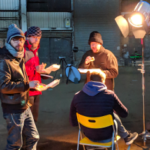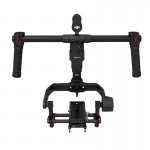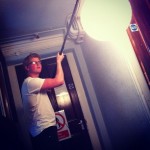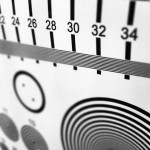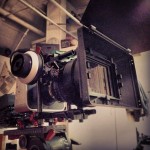So the main problem is that the big movie cats often use giant lighting fixtures with 18,000 Watts of power driving them, blasted through giant diffusion silks. Us film kittens can’t do that because it would cost more monies than are currently available to us. Hence, we must resort to squeezing light from tiny fixtures with around 120-2400W total power.
The most obvious choice for most is the widely available Redhead. What’s great about Redheads, is that they are 800W tungsten halogen fixtures with barn doors and a basic spot control. The tungsten part is good because this gives us a CRI (Colour Rendering Index) of 100%. The halogen part is good for longevity, as this allows the filament’s evaporated particles to be recycled. The barn doors and spot control allows us to shape the light and direct it very easily. The down side is that they’re hot, fragile, and produce light which is a much warmer CT (Colour Temperature) than daylight.
The daylight CT issue can be sorted pretty easily by using a metal halide bulb in a similar fixture. The metal halide is a type of discharge lamp which uses a cocktail of metal compounds to get a decent CRI. The movie cats sometimes use the expensive >90% CRI version of these, and they call them HMIs (Halogen Metal Iodide). You get about four times the brightness per Watt with them in comparison to incandescents. However, there is a trade off. These bright brutes take forever to reach a stable condition where you can actually use them to film. When you first turn them on, your set will look like a cheap haunted house, everything will be green. Give it about five minutes, and the rest of the metal compounds will join the party and you’ll have a nice bright daylight balanced high CRI source. They also have a horrible cool down process, so if you switch it off, be sure you don’t need it for the next ten minutes because it’s not going to want to turn back on. Another downer is getting your hands on a cheap Redhead like fixture. Nobody stocks them, it’s going to have to be an ebay purchase and you’ll have to build your own barn doors.
The next contestant is fluorescent, or Flos. The CRI of fluorescent always used to be terrible. People complained and scientists found that office workers need daylight to work efficiently, or at least better light than the yellow-green crap produced by office lights at the time; and now we have daylight balanced high CRI flo tubes. Kinoflo is the popular brand, and they’re a pretty good price for the light they produce. You can choose which CT bulbs you want and swap them out accordingly. The only problem which remains is that if you drop the fixture it will definitely smash all the bulbs leaving you with the bulbs of different CT and a pricey replacement cost.
Enter the youngest kid on the block, the humble LED. Far from the “little light bulb that blinks” on Buzz Lightyear’s arm, LEDs have come a long way from electronics indicators. The great thing about LEDs is that they are incredibly efficient. About 10% of the power for the same brightness. That’s mainly down to the fact that they don’t emit infra red, so none of the energy is wasted on heat. They are just slightly warm to the touch. LEDs can also be referred to as solid state lighting, as there’s no filament they are the sturdiest of all lighting types. So perfect for moving location quickly, and you wont have to feel so guilty about using electricity from whoever owns your shooting location. What about CRI? Usually, LEDs emit just one or two frequencies of light. So on their own their CRI would effectively be 0% or thereabouts. To get a broader spectrum of light, a mixture of phosphors coating the inside of an LED’s tiny bulb absorbs the single frequency (usually blue/ultraviolet) and emits a few others, yellow mainly. With over ten years of research and development into the technology, the “warm white” LEDs you can get today can have something around 90% CRI. They’re very small, but are far cheaper than normal light bulbs, so you can afford to buy 1000, which is roughly equivalent to a Redhead in terms of brightness.
Unfortunately, because so many people now know that LEDs are the best option for film makers in almost every way, they can be ridiculously expensive. If you stay away from brand names, they’re perfectly affordable, but they wont tell you the CRI, and that’s probably for a good reason. We’re going to test the theory.
Below are a bunch of pictures taken through a spectroscope I built with gaffa tape and a blank DVD. They show the spectrum of various lights I found around the office. Including, most notably, a cheap Chinese 1000 LED panel.






